Enjoy DatePsychology? Consider subscribing at Patreon to support the project.
In this article I review 13 recent meta-analyses and 70 separate studies on associations between testosterone and personality, behavioral, or physical outcomes.
Behavioral associations include: risk-taking behavior, aggression, dominance, competitiveness, criminal behavior, and mating success. Physical associations include: physical attractiveness, facial masculinity, muscularity and sport performance outcomes. This is not a comprehensive list, but these are some main associations that will be covered.
A pervasive pop cultural belief is that testosterone is closely associated with one or more of the traits listed above. In fact, natural testosterone levels have null-to-small correlations with almost all of these.
A quick tutorial on effect sizes
You have probably heard: “X will raise your testosterone,” or that “X is associated with high testosterone.”
It’s much less likely that you have heard by how much. This is because, as we will see from the following research, it is almost always small. People telling you to raise your testosterone are usually selling a product and service. They don’t want you to know the small size of the effects.
Effect size is a measure of how small. Effect size in statistics is how closely two variables are related. It is also the size or the magnitude of a relationship. You can use effect size as a proxy for meaningfulness. Is the relationship large? If so, it might be meaningful.
People confuse statistical significance with effect size. Significance in statistics does not mean significant in common parlance. It tells you nothing about the size or meaningfulness of a relationship. You must use an effect size measure for this.
Fortunately this is fairly simple. Effect sizes will be between -1 and 1. Interpret them as such:
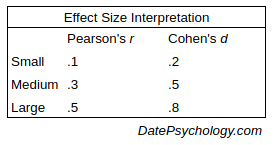
This is a basic understanding of effect size. Statisticians have much nuance to add. However, this is the most common and most conventional guideline (Cohen, 2013). It will give you a frame of reference for interpreting the following research.
Testosterone and risk-taking
Risk-taking is considered to be a masculine trait. Kurath & Mata (2013) conducted three separate meta-analyses across 108 independent effect sizes. The relationship between testosterone and risk-taking was small (.12).
Dekkers et al. (2019) investigated the relationship between testosterone and risk-taking in a more recent meta-analysis of 33 studies, controlling for cortisol as a moderating variable. The main effect of testosterone was very small (-.062).
Testosterone and Big Five (OCEAN) personality traits
The Big Five model of personality is among the most common and well-validated personality taxonomies in psychology. We see consistent gender differences in the Big Five model. Might we see a difference in testosterone’s effect on personality?
Not much. Sundin et al. (2021) aggregated 25 separate samples for a total of 3964 participants. No robust relationships were found between testosterone and any Big Five personality variables. Testosterone had only a very small relationship with conscientiousness (-0.05).
Testosterone and aggression
Aggression is a trait perceived to be associated with testosterone. We have pop cultural memes about it: aggressive men have high T, the smell of T in the locker room, and “roid rage” as examples. Is natural range testosterone really associated with aggression?
In a highly cited study by Book et al. (2001), a meta-analysis of 45 studies with 54 independent effect sizes found only a weak relationship (.14) between testosterone and aggression. Additionally, Book et al. found that the relationship between aggression and testosterone was strongest in the 13-21 age group. Archer et al. (2005) attempted to replicate Book et al., but found an even lower relationship (.09).
In the Dekkers et al. (2021) meta-analysis previously cited, the main effect of testosterone on aggression was almost nothing at -0.043. Interactions with testosterone on aggression and dominance showed a similarly small effect at -0.12.
Here is a forest plot from Dekkers et al:
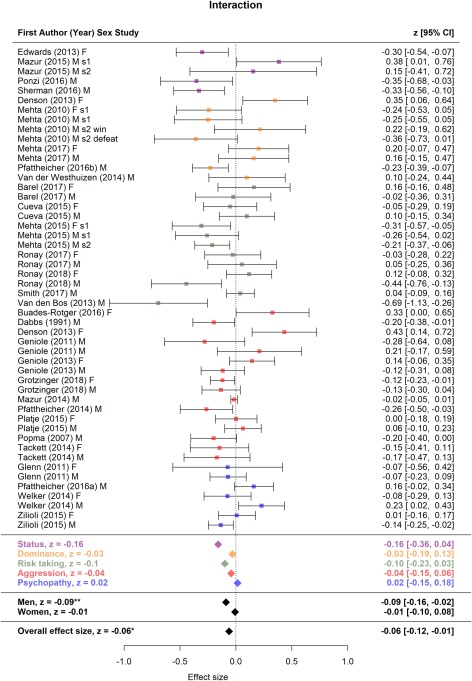
You can see two things from this. First, this meta-analysis covered main effects of testosterone on status, dominance, risk taking, aggression and psychopathy. These are the colored dots at the bottom. Save for psychopathy, all are negative and very small.
Second, a forest plot can show you the degree of variation between individual study results. Basically, the degree to which studies fail to overlap in their results. This is called heterogeneity. You can see that some research shows a positive correlation between T and aggression, while some shows a negative correlation. The results of studies on T and aggression are all over the place.
There are many reasons why that may be. However, it is not what we should expect when there is a consistent relationship between two variables. Here is a forest plot from an unrelated paper by Melendez-Torres (2015) as an example:
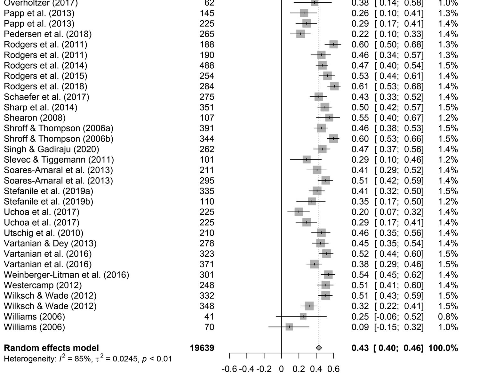
You can see how the individual studies line up neatly all to the right of the line, indicating a consistent positive correlation across studies.
This is something to consider when we look at further meta-analyses on testosterone and behavior. In many cases, if we see a small correlation it is not because a small correlation is consistently being found across the research. It is because the results are inconsistent and all over the place.
Geniole et al. (2020) conducted a large meta-analysis on contextual changes in testosterone and aggression. Past research has largely examined baseline testosterone, finding little difference. Testosterone changes with the environment — situational cues are hypothesized to acutely increase testosterone. But by how much?
Geniole et al. found a very small relationship with aggression and baseline testosterone (.054). Following experiments designed to simulate competition and even following exogenous administration of testosterone, changes in the aggression-testosterone relationship were still small (.1). It turns out that situations do influence our testosterone level acutely, and that testosterone increases predict higher aggression, but not very much.
The Geniole et al. study is relevant to testosterone grifters telling you that higher T will make you more aggressive, or that engaging in competitive situations will give you higher T. Grifters never tell you how much. It isn’t much.
Let’s look at one final study on testosterone and aggression. This time, exogenous testosterone at supraphysiological doses. Injecting testosterone at 500mg. This is the size of a conventional beginner steroid cycle that might be used by a bodybuilder. Surely this would make men more aggressive, right? Just as the “roid rage” meme would indicate.
Chegeni et al. (2021) conducted a meta-analysis of steroid users. They included twelve randomized-controlled trials (RCTs). The relationship between self-reported aggression and steroid use was only .17, while no relationship existed between steroid use and observer-reported aggression. In RCTs administering >500mg of testosterone, well above the natural range, no effect was observed between aggression and testosterone. No effect was observed between aggression and long-term (up to 14 weeks) testosterone use.
This is the forest plot from Chegeni’s meta-analysis:
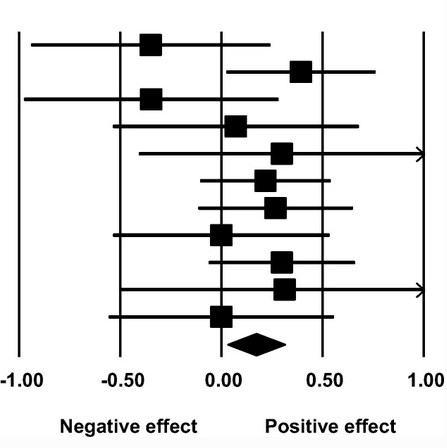
You can see that this has less heterogeneity. Most RCTs of testosterone administration did increase self-reported aggression, although effects remained small.
Testosterone levels in criminals
Testosterone is a hormone with a role in sexual function. Therefore, it has been hypothesized that criminals convicted of sex crimes may have higher levels of testosterone. Wong & Gravel (2018) conducted a meta-analysis of testosterone in sex offenders. There was no relationship between testosterone and being a sex offender. Book et al. (2001) similarly found no relationship between testosterone levels and other criminal offenders.
Here is the forest plot from Wong et al.:
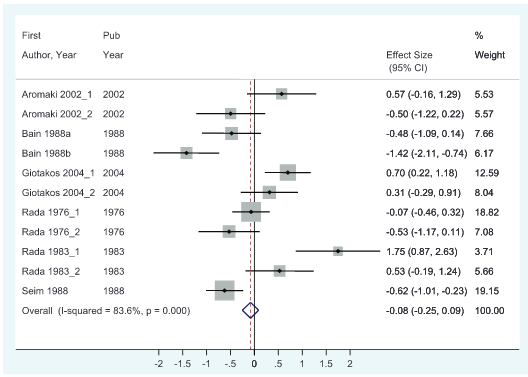
Here we see high heterogeneity, a similar trend from some of the past meta-analyses. Inconsistent direction of effects.
Testosterone and pair bonding
Testosterone has a strong role in the pair bonding behavior of some animals. Does testosterone have a similar role in humans?
Grebe et al. (2019) conducted a meta-analysis of 79 studies across 93 effect sizes on testosterone and pair bonding. Testosterone predicted positive, but small, relationships with pair bonding (.15), mate acquisition behavior (.21) and fatherhood (.19).
Here two plots from this paper:
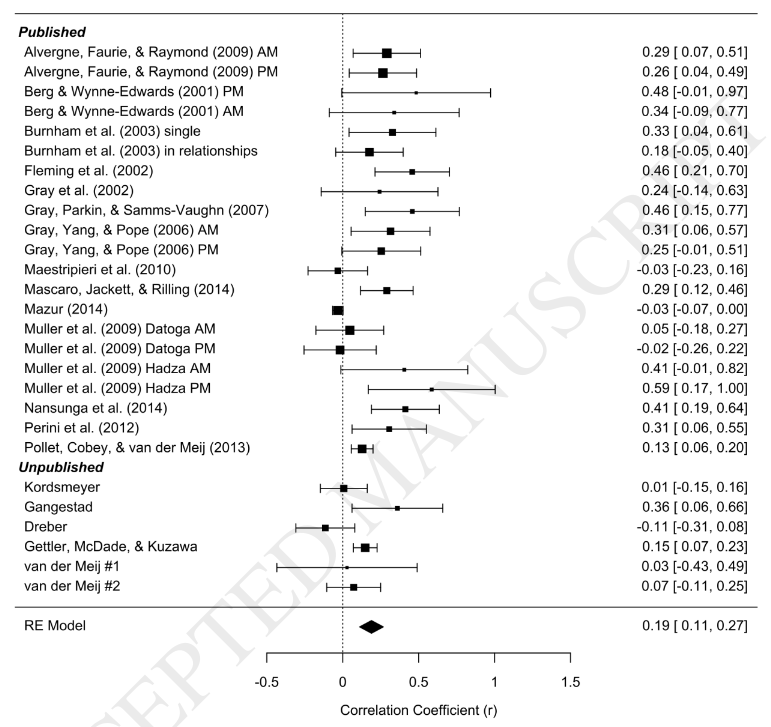

Here we see effect size estimates somewhat consistently to the right of the line, indicating a consistent direction of the findings. Lower heterogeneity than the research we have seen up to this point. This effect is most likely real, but small, and is consistent with the role of testosterone in other mammals.
There is a meme that men in relationships, or married men, are low testosterone “betas.” I have written previously on what the manosphere gets wrong about alphas and betas. It was always a bizarre piece of ideology that men in relationships with children (who women picked over other men to pass on the genes of) were undesirable “beta males.” Here is a small piece of further evidence that the long term male partners of women are not low testosterone.
Testosterone and competition vs cooperation
Does testosterone make you more competitive or more cooperative? In pop culture, high T is the hormone of brutes: it has a major role in aggression, competition and violence. Yet in research on animal bonding, we see a major role of testosterone in cooperative behavior. For humans, it turns out it may not play a strong role in either direction. A meta-analysis of 41 studies by Yang et al. (2021) found no effect of exogenous testosterone administration on cooperative behaviors.
Here is the plot from Yang et. al:
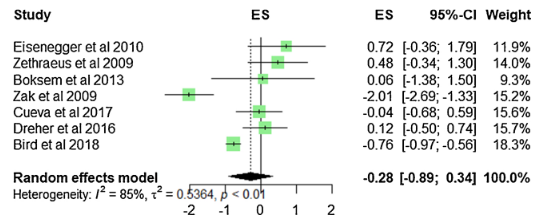
Of 41 studies only 7 examined testosterone specifically. This is a very recent meta-analysis. It is likely we don’t have many studies where researchers injected people with testosterone and measured cooperative behaviors. From what we do have we see weak and inconsistent effects upon cooperative behaviors. This has been a recurring theme in behavioral measures up to this point.
Testosterone and dominance
In an earlier study (Dekkers et al., 2019) we saw that testosterone had a weak negative relationship with dominance (-.12). The forest plot for this can be found in the previous section on aggression.
Kowal et al. (2021) found no effect of testosterone on dominance. Kordsmeyer et al. (2018; 2019) found no effect of testosterone on dominance (measured as grip strength) or facial dominance (measured by facial dimorphism). Kandrik et al. (2017) similarly found no effect of testosterone on dominance, while an interaction between testosterone and cortisol predicted slightly lower dominance (-.11).
Neave et al. (2003) found that a low 2D:4D ratio — a digit ratio measure associated with prenatal testosterone exposure — predicted dominance, but free testosterone did not. Free testosterone was also unassociated with the 2D:4D ratio. Neave et al. said: “This is perhaps not so surprising, if male facial characteristics are organized before birth and then sculpted during puberty, then we should not expect fluctuating levels to be related to perceived facial characteristics.”
Unfortunately, it looks like sunning your balls and eating raw liver (common tropes in the testosterone griftosphere) are not going to give you a chiseled jawline.
Bird et al. (2017) conducted an experiment using exogenous testosterone at approximately three times the natural level. No relationship was found between artificially high testosterone and male-on-male perceptions of dominance. Welling et al. (2016) did find, however, that administration of exogenous testosterone made men subjectively feel like they were more dominant.
That testosterone does not predict dominance may be a very counterintuitive finding if you have been influenced by the lore of T in popular culture.
Note that there was never an inherent reason to expect that testosterone should influence dominance. Everything that we know about testosterone is based on hormonal research. It isn’t something that we see or experience in the world around us by observation, as we might the mating behavior of birds. We don’t observe the testosterone levels of the dominant people around us.
That we have come to believe testosterone makes men more dominant is entirely because someone told us it was true. We memed it into existence. At this point you should ask yourself: who told me that, why do I believe them, and did they support it with numbers.
Testosterone and facial masculinity
Kordsmeyer et al. (2019) found no relationship between T and facial masculinity, as measured by facial sexual dimorphism. Kowal et al. (2021) found no relationship between beard length and T. Peters et al. (2008) found no relationship between raw (free) testosterone and ratings of masculinity, and a small (.11) correlation with testosterone residuals and ratings of masculinity.
Mentioned previously, Neave et al. (2003) found a relationship with 2D:4D ratio (prenatal testosterone exposure) and masculinity, but no relationship with current testosterone levels and masculinity. Whitehouse et al. (2015) similarly found a correlation between prenatal testosterone and masculinity, but not with circulating testosterone levels and masculinity. Honekopp et al. (2013) also found a relationship between the 2D:4D ratio and facial masculinity.
This is expected. Sexual differentiation of the fetus is effected by testosterone in the womb. By the time you are an adult your face is developed. If you are reading this you are not a fetus, so this will not apply to you.
Penton-Voak & Chen (2004) did find an association with salivary testosterone and facial masculinity, but the relationship was small. Participants were only able to distinguish between faces of men with low and high testosterone slightly above chance.
Honekopp et al. (2007) found no relationship between testosterone and any of the four variables: facial attractiveness, facial masculinity, bodily attractiveness, or bodily masculinity.
A digression with a few words about Honekopp et al. This was a study on the relationship between physical attractiveness and physical fitness. The correlation was medium-high for physical fitness and bodily attractiveness (.47), which the authors described as unusually high for an attractiveness measure. I have said it before but I will reiterate it once more: for men, one of the best things you can do to increase your attractiveness is to get jacked.
Testosterone and attractiveness
Does higher testosterone predict attractiveness? Fitness gurus, “seduction experts,” and dating coaches may tell you that it does. What does the research show?
Kordsmeyer et al. (2018; 2019) found no association between testosterone levels and attractiveness across two studies. Kandrik et al. (2017) found no association. Honekopp et al. (2007) found no association. Passakova et al. (2019), no association. Penton-Voak & Chen (2004), no association.
Peters et al. (2008) looked at interactions between testosterone and three variables: attractiveness, masculinity, and mating success. Testosterone did not predict attractiveness nor masculinity. We will look more into mating success below.
Honekopp et al. (2013) performed a meta-analysis on facial attractiveness, testosterone and the low 2D:4D ratio expected to result from prenatal testosterone exposure. There was no relationship between the 2D:4D ratio and facial attractiveness. Neave et al. (2003) similarly found no association between either circulating testosterone or the 2D:4D digit ratio and attractiveness.
Swaddle et al. (2002) found no association between T and attractiveness, when manipulating faces to appear more dimorphic as would be expected from higher prenatal testosterone exposure. When examining high testosterone faces, Swaddle et al. found surprisingly strong negative correlations for frontal (-.636) and profile (-0.710) facial attractiveness. Additionally, the most preferred faces with low testosterone appeared more dimorphic (less low T expression), while the most preferred faces with high testosterone appeared less dimorphic (less high T expression).
Swaddle et al. explained this as a strong convergent selection process for average testosterone in the population. This is consistent with much past research on facial attractiveness, which has shown that faces with average features are perceived as more attractive than faces with pronounced, extreme, or dimorphic features (Jones et al., 2007; Rhodes et al., 2002; Rhodes et al., 2005).
Krejza et al. (2021) found a similar negative relationship between total testosterone and attractiveness. Men with higher total testosterone were rated as less attractive by women. Krejza et al. also found that higher testosterone levels in men were less attractive to ovulating women. We can add this to the growing pile of evidence against the dual mate hypothesis, which posited that ovulating women were more attracted to men with high testosterone.
Testosterone and mating success
OK — so T doesn’t predict attractiveness. Does it predict mating success?
In Grebe et al. (2019) we saw that testosterone had a small positive association (.15) with pair bond formation and for fatherhood (.19). For mate acquisition behavior, or the pursuit of a mate, it was still small (.215).
Kordsmeyer et al. (2018) found no relationship between T and mating success, measured by sexual partners within the last twelve months, lifetime sexual partners and lifetime number of one-night stands.
Peters et al. (2008) measured mating success and found only a weak correlation (.11) with testosterone. The correlation disappeared when controlling for lifestyle factors that covaried with testosterone.
Pollet et al. (2011) found a similarly small correlation (.137) between testosterone and lifetime number of sexual partners. Observe the distribution:

The difference in sexual partner count by testosterone is driven almost entirely by men in the first quartile. This is a trend that we will see replicated later in research on testosterone and physical strength. When we do see differences within the natural range, it is usually driven by the lowest T men in the first quartile. Note that these are men still within the natural range, not low T or hypogonadal men. Outside of that first quartile we see little difference.
To illustrate the practical implication of this, if we use a natural testosterone reference range from 300ng/dl to 1000ng/dl the first quartile will be between 300ng/dl and 475ng/dl. If your testosterone is over 475ng/dl you are unlikely to see meaningful changes from increasing it.
Puts et al. (2015) found that testosterone level had a medium sized correlation with sociosexuality (.37) — the first effect size above small that we have seen up to this point. However, when controlling for sociosexuality the relationship between testosterone and sociosexual behavior (more sexual partners) went negative. In a second study, Puts et al. found that testosterone had a similarly sized positive correlation with sociosexuality (.3) but a negative correlation with number of sexual partners (-.27). Additionally, when controlling for physical attractiveness the relationship remained the same.
How should we interpret Puts et al. — why did lower T men have more sexual partners? Well, we have already seen from the multiple meta-analyses that T is an inconsistent predictor of most behavior. This may be all there is to it. An interpretation that Puts et al. made in the paper is that low T men may be more likely to lie about their number of sexual partners, thus overcompensating. A more charitable interpretation they gave is that more frequent sexual behavior (or less sexual frustration) reduces testosterone.
Testosterone on strength, muscularity and athletic performance
Pasanen et al. (2022) conducted the first meta-analysis on prenatal testosterone estimated by 2D:4D ratio and grip strength. Grip strength is highly correlated with bodily strength across multiple measures, including conventional exercises like squats or bench press. Low 2D:4D ratio had a small negative relationship (-.15) with grip strength. A negative correlation between 2D:4D ratio in this case implies a higher level of strength based on prenatal testosterone exposure. This is consistent with the previous research we have seen on 2D:4D ratio and facial masculinity. Your prenatal womb environment will determine, in large part, these features.
Izquierdo et al (2004) examined the testosterone levels of cyclists, weightlifters and a control population. Although cyclists had lower testosterone on average, weightlifters did not have higher testosterone than the control. Testosterone level did not predict strength measures (one-repetition maximum, average of muscular power and maximal power output). Testosterone level was inversely related with maximal workload (-.39 total testosterone, -.41 free testosterone).
Hakkinen et al. (1988) conducted a highly-cited study on a small sample of Finnish weightlifting champions. The purpose of this study was to determine if a long-term weightlifting program could raise basal testosterone levels. For the moment, let’s just look at the testosterone levels of top tier lifters. The average time these lifters had trained was seven years. Their mean testosterone level was 19.8nmol/l, SD of 5.3 nmol/l. This is 571ng/dl with a standard deviation of 153ng/dl. Basically the same as the general population. You might have expected elite athletes to have testosterone levels in the upper range, but this was not the case.
It is notable that this study was conducted in 1988, when testosterone levels were also higher on average. Lokeshwar et al. (2021) found that testosterone in men has declined from an average 605ng/dl in 1999 to 451ng/dl in 2016. Travison et al. (2007) found a similar decline in older men (age 45-80) from an average of 501ng/dl in 1989 to an average of 319ng/dl in 2004.
Balthazar et al. (2012) conducted an analysis of eight professional triathletes and similarly found no relationship between natural testosterone level and sport performance.
Crewther et al. (2016) examined the testosterone levels of male and female teenage Olympic weightlifting competitors. While testosterone predicted performance for girls, there was no correlation between testosterone levels and performance for boys.
Bermon et al. (2017) tested elite track and field athletes (795 male, 1332 female) competing at the Moscow IAAF World Championships. Across 27 different track and field events, testosterone level was only correlated with outcomes for male sprinters. For men in the throwing sport category, for example javelin or shot put, testosterone levels were lower on average.
For sprinters, the range of testosterone was between 398ng/dl and 635ng/dl, with a mean of 508ng/dl. The category of athletes with the highest T had testosterone levels similar to the mean of the non-athletic general population.
Sönksen et al. (2018) measured the testosterone of 234 elite athletes (146 men). They found that “testosterone concentrations in the powerlifters are on average remarkably small.” 25.4% of male elite male athletes had low levels of testosterone. Not just low within the natural range, but truly hypogonadal.
Here is a dot plot of testosterone levels in male elite athletes from Sönksen et al.:

This plot is in nmol/l. I have placed the conversion to ng/dl on the chart in red. Elite athletes seem to fall on a distribution similar to the general population, with most clustering between 400ng/dl and 600ng/dl.
Mouser et al. (2016) examined if normal range testosterone was associated with differences in lean body mass and body fat. While men in the third and fourth quartile had greater lean body mass and lower body fat than men in the first quartile, differences remained small (<.3). No differences were reported in the top three quartiles, a range of 439ng/dl – 798ng/dl.
Recall that we saw a similar relationship in Pollet et al. (2011) on mating success. The bottom quartile of testosterone was associated with lower mating success, but no difference was found across the rest of the range.
The effects of exercise on testosterone levels
Physical exercise is recommended to raise your testosterone levels. Indeed it does — but how much? You could make a guess from the previous studies on athletes. Despite being fit, lean and athletic, the testosterone levels of athletes are similar to the general population. Let us also look at direct measures.
Research has shown an acute, short term rise in testosterone immediately following exercise (Kvorning et al., 2007; Kraemer et al., 2008; Linnamo et al., 2005; Hakkinen et al., 2000; Pullinen et al, 2002; Similios et al., 2003; Willoughby & Taylor, 2004; Ratamess et al., 2005). D’andrea et al. (2020) conducted a meta-analysis on 48 studies of testosterone response following exercise. Moderate to high intensity exercise produced acute increases in testosterone, which returned to baseline one hour following activity.
You may have heard “squats raise your T.” This is the kind of research that spawned that belief. Yes, resistance training will raise your T — by a modest amount for about an hour.
Findings on the long-term effects of exercise on testosterone, however, are mixed.
Hayes & Elliott (2019) performed a meta-analysis of 22 studies, including a large number of randomized-controlled trials, in older men under 60 years old. They found no long term increase in testosterone following strength training and concluded:
“There is a pervasive belief that resistance exercise increases basal testosterone over time. However, that was not observed in older males in this meta-analysis” and “when testosterone is within a “normal” physiological range, neither the acute elevation (West et al., 2010), nor the basal concentration appear to drive resistance training adaptations in an older population.”
This is consistent with the research of Kraemer et al. (1999, as cited in Hayes & Elliott, 2019) and Hakkinen et al. (2002, as cited in Hayes & Elliott, 2019), which similarly found no long term increase in testosterone. Timon et al. (2007) similarly found no increase in testosterone after four weeks of strength training.
Here is the forest plot of Hayes & Elliott (2019), showing the effects of resistance training on testosterone levels:
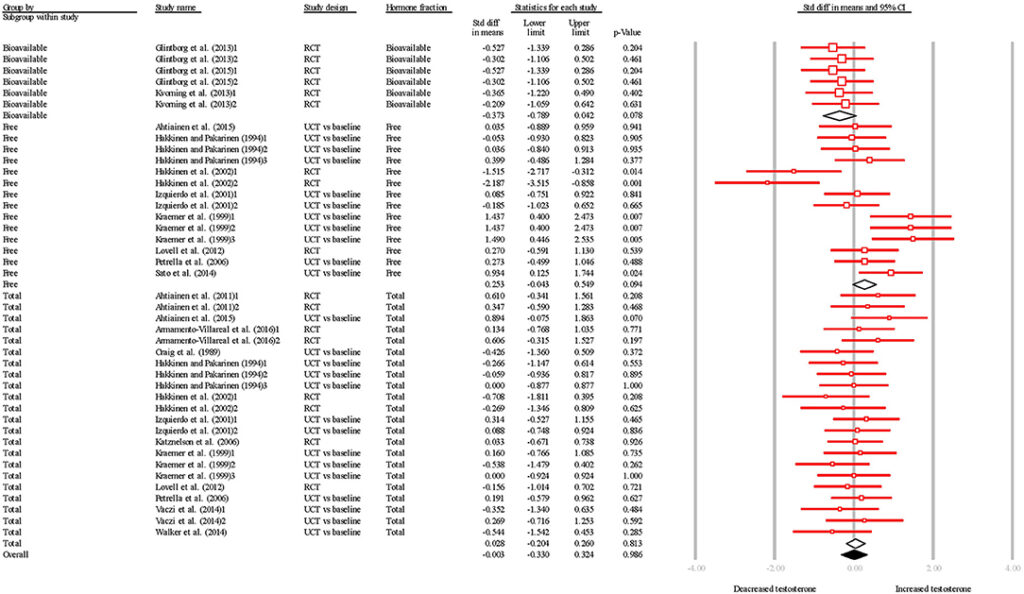
Staron et. al (1994) performed a resistance training study on 13 untrained men and found an increase in testosterone following a nine week training program. They also found large (calculated as r-squared) correlations with testosterone levels and type IIa (.39) and type IIb (.46) muscle fibers. This represented a fairly decent testosterone increase of approximately 150ng/dl on average:
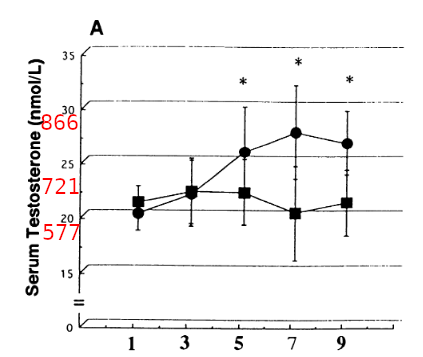
Hakkinen et al. (1988), mentioned previously, found a similar increase in the testosterone levels of 9 Finish weightlifting champions over the span of two years:

The mean increase was from 19.8nmol/l, or 571ng/dl, to 25.1nmol/l, or 724ng/dl. The standard deviation of the new mean was 5.2nmol/l, or 150ng/dl.
These two studies have small samples and are nonrepresentative. I wanted to include them nonetheless to illustrate the upper range of what you should expect from lifting to increase your testosterone, assuming that you begin as a man within the normal range.
Heritability of testosterone levels
In the past I have discussed the “50/0/50 rule” — a description of the observation across behavioral genetic research that approximately half of behavioral traits are heritable. Testosterone levels also follow this approximately, with heritability estimates ranging from 40% to 60% (Harris et al., 1998; Hoekstra et al., 2006; Travison et al., 2014). The degree to which your testosterone can be raised will be bound within that window of genetics.
Testosterone grifts
Unfortunately, a great deal of the discussion surrounding testosterone has been to promote grifts. Testosterone grifts consist of multiple parts: making you fearful that you have “low T,” promising you a solution to raise your T, and exaggerating the effect of testosterone.
Specific forms of T grifts: supplements that claim to raise T, “lifestyle” and fitness programs that claim to raise T, fad diets, hormone analyses, and even to some extent testosterone therapy clinics.
The ubiquity of testosterone grifts has given form to a false consensus in popular culture about the magnitude of testosterone’s effects. You may have heard incorrect claims about testosterone repeated so often that you believe them. This is entirely normal — this is how we form beliefs. We tend to believe the first information we receive (the primacy cognitive bias) and we tend to believe what is repeated more frequently (the illusory truth, reiteration effect, or repeat exposure effect).
You may have found this article because you were trying to raise your own testosterone or because you suspected your T may be low. You may have been told that raising your testosterone is very important. That higher T will change your life. Perhaps you have already embarked on a testosterone-raising quest. Maybe you have already shelled out some cash, or made major lifestyle changes.
If that is the case this article may have been bad news for you. As we have seen, raising your T within the natural limit won’t turn you into an Alpha Male™. You would be lucky if it shifted your behavioral outcomes at all.
Think back on who told you to raise your testosterone, how and why:
Did they tell you how much you should expect to raise it by? Did they tell you how large of an effect (in numbers) raising your testosterone will have on your desired outcome? Probably not on both counts. You are told “raise your testosterone,” but you are not told that the increase will be marginal.
The testosterone blackpill is that you shouldn’t expect to raise your testosterone a meaningful level by any natural method, that the effect of natural testosterone on almost all traits (behavior, personality, physical) is only ever small when not zero, and that the small changes you are able to achieve are unlikely to result in major outcomes for you.
The soyboy meme
The soyboy is perhaps the most popular testosterone-related meme. It is a behavioral and physiognomic meme. You can tell if someone has low testosterone from their feminine behavior, their facial features or both. This meme was in turn derived from the belief that phytoestrogens in soy will lower testosterone or otherwise feminize men (soy does not: see meta-analyses by Hamilton-Reeves et al. (2010) and Reed et al. (2021)). The most common depiction is the soyjack, the soy wojak:

As we have seen up to this point, testosterone levels do not have large correlations with personality, behavioral or even physical masculine variables. As the correlations are consistently small, you should not expect to be able to detect high or low testosterone in a given individual beyond chance. Neither by behavior, nor by what their face looks like.
In fact, given the low correlations if you tried to predict the likelihood of someone having high or low testosterone based on facial or behavioral traits you should expect to perform worse than chance. See Why AWALT Will Be Wrong Most Of The Time for an explanation of the math behind this.
Why it isn’t over
It may feel demotivating to learn that raising your T will not solve your problems or convert you into a new person.
Yet some recommendations to raise your T are still legitimately good for you. You should lose weight if you are obese. You should exercise. You should eat healthy food. You should sleep an adequate amount. The value in these behaviors is not that they will skyrocket your T. They will have lasting benefits for your physique and your mental health regardless of their effect on your testosterone.
That said, I recommend avoiding anyone trying to sell you a quick fix in a bottle. I have not covered “T boosting” supplements; much has been said on these gimmicks. Avoid. You should avoid fads and alternative health gimmicks that promote “one easy trick” of any kind as well.
Conclusion
We consistently see null, small and inconsistent associations with testosterone and behavioral traits. Moreover, these are the very behavioral traits we have come to associate with “high T” in pop culture. Across limited variables, specifically mating stress and muscularity, we see associations with outcomes for the bottom quartile of testosterone levels. If you are in the bottom quartile of men you may see a benefit from raising your testosterone levels through lifestyle changes or resistance training.
Summary of points
- Testosterone only has null-to-small associations with masculine personality traits and behaviors.
- Testosterone has no relationship with physical attractiveness in men.
- Testosterone may have a small association with mating outcomes for men.
- Testosterone, surprisingly, has no relationship with sport performance and outcomes — at least within the natural range.
- If your testosterone is borderline low, within the first quartile, you may see some benefits from raising it.
- But, the degree to which you are able to raise your testosterone, even optimistically, is limited.
References
Archer, J., Graham-Kevan, N., & Davies, M. (2005). Testosterone and aggression: A reanalysis of Book, Starzyk, and Quinsey’s (2001) study. Aggression and violent behavior, 10(2), 241-261.
Balthazar, C. H., Garcia, M. C., & Spadari-Bratfisch, R. C. (2012). Salivary concentrations of cortisol and testosterone and prediction of performance in a professional triathlon competition. Stress, 15(5), 495-502.
Baumgartner, R. N., Waters, D. L., Gallagher, D., Morley, J. E., & Garry, P. J. (1999). Predictors of skeletal muscle mass in elderly men and women. Mechanisms of ageing and development, 107(2), 123-136.
Bermon, S., & Garnier, P. Y. (2017). Serum androgen levels and their relation to performance in track and field: mass spectrometry results from 2127 observations in male and female elite athletes. British journal of sports medicine, 51(17), 1309-1314.
Bird, B. M., Geniole, S. N., Little, A. C., Moreau, B. J., Ortiz, T. L., Goldfarb, B., … & Carré, J. M. (2017). Does exogenous testosterone modulate men’s ratings of facial dominance or trustworthiness?. Adaptive Human Behavior and Physiology, 3(4), 365-385.
Book, A. S., Starzyk, K. B., & Quinsey, V. L. (2001). The relationship between testosterone and aggression: A meta-analysis. Aggression and Violent Behavior, 6(6), 579-599.
Chegeni, R., Pallesen, S., McVeigh, J., & Sagoe, D. (2021). Anabolic-androgenic steroid administration increases self-reported aggression in healthy males: a systematic review and meta-analysis of experimental studies. Psychopharmacology, 238(7), 1911-1922.
Cohen, J. (2013). Statistical power analysis for the behavioral sciences. Routledge.
Crewther, B., Obminski, Z., & Cook, C. (2016). The effect of steroid hormones on the physical performance of boys and girls during an Olympic weightlifting competition. Pediatric Exercise Science, 28(4), 580-587.
D’andrea, S., Spaggiari, G., Barbonetti, A., & Santi, D. (2020). Endogenous transient doping: physical exercise acutely increases testosterone levels—results from a meta-analysis. Journal of endocrinological investigation, 43(10), 1349-1371.
Dekkers, T. J., van Rentergem, J. A. A., Meijer, B., Popma, A., Wagemaker, E., & Huizenga, H. M. (2019). A meta-analytical evaluation of the dual-hormone hypothesis: Does cortisol moderate the relationship between testosterone and status, dominance, risk taking, aggression, and psychopathy?. Neuroscience & Biobehavioral Reviews, 96, 250-271.
Geniole, S. N., Bird, B. M., McVittie, J. S., Purcell, R. B., Archer, J., & Carré, J. M. (2020). Is testosterone linked to human aggression? A meta-analytic examination of the relationship between baseline, dynamic, and manipulated testosterone on human aggression. Hormones and behavior, 123, 104644.
Grebe, N. M., Sarafin, R. E., Strenth, C. R., & Zilioli, S. (2019). Pair-bonding, fatherhood, and the role of testosterone: A meta-analytic review. Neuroscience & Biobehavioral Reviews, 98, 221-233.
Hakkinen, K., Pakarinen, A., Alen, M., Kauhanen, H., & Komi, P. V. (1988). Neuromuscular and hormonal adaptations in athletes to strength training in two years. Journal of applied physiology, 65(6), 2406-2412.
Hakkinen, K., Pakarinen, A., Kraemer, W. J., Newton, R. U., & Alen, M. (2000). Basal concentrations and acute responses of serum hormones and strength development during heavy resistance training in middle-aged and elderly men and women. Journals of Gerontology-Biological Sciences and Medical Sciences, 55(2), B95.
Hamilton-Reeves, J. M., Vazquez, G., Duval, S. J., Phipps, W. R., Kurzer, M. S., & Messina, M. J. (2010). Clinical studies show no effects of soy protein or isoflavones on reproductive hormones in men: results of a meta-analysis. Fertility and sterility, 94(3), 997-1007.
Harris, J. A., Vernon, P. A., & Boomsma, D. I. (1998). The heritability of testosterone: a study of Dutch adolescent twins and their parents. Behavior genetics, 28(3), 165-171.
Hayes, L. D., & Elliott, B. T. (2019). Short-term exercise training inconsistently influences basal testosterone in older men: a systematic review and meta-analysis. Frontiers in physiology, 9, 1878.
Hodges-Simeon, C. R., Hanson Sobraske, K. N., Samore, T., Gurven, M., & Gaulin, S. J. (2016). Facial width-to-height ratio (fWHR) is not associated with adolescent testosterone levels. PloS one, 11(4), e0153083.
Hoekstra, R. A., Bartels, M., & Boomsma, D. I. (2006). Heritability of testosterone levels in 12-year-old twins and its relation to pubertal development. Twin Research and Human Genetics, 9(4), 558-565.
Hooper, D. R., Kraemer, W. J., Focht, B. C., Volek, J. S., DuPont, W. H., Caldwell, L. K., & Maresh, C. M. (2017). Endocrinological roles for testosterone in resistance exercise responses and adaptations. Sports Medicine, 47(9), 1709-1720.
Hönekopp, J., Rudolph, U., Beier, L., Liebert, A., & Müller, C. (2007). Physical attractiveness of face and body as indicators of physical fitness in men. Evolution and Human Behavior, 28(2), 106-111.
Hönekopp, J. (2013). Digit ratio (2D: 4D) and male facial attractiveness: new data and a meta-analysis. Evolutionary Psychology, 11(5), 147470491301100501.
Izquierdo, M., Ibáñez, J., Häkkinen, K., Kraemer, W. J., Ruesta, M., & Gorostiaga, E. M. (2004). Maximal strength and power, muscle mass, endurance and serum hormones in weightlifters and road cyclists. Journal of sports sciences, 22(5), 465-478.
Jones, B. C., DeBruine, L. M., & Little, A. C. (2007). The role of symmetry in attraction to average faces. Perception & psychophysics, 69(8), 1273-1277.
Kordsmeyer, T. L., Hunt, J., Puts, D. A., Ostner, J., & Penke, L. (2018). The relative importance of intra-and intersexual selection on human male sexually dimorphic traits. Evolution and Human Behavior, 39(4), 424-436.
Kordsmeyer, T. L., Freund, D., Pita, S. R., Jünger, J., & Penke, L. (2019). Further evidence that facial width-to-height ratio and global facial masculinity are not positively associated with testosterone levels. Adaptive Human Behavior and Physiology, 5(2), 117-130.
Kordsmeyer, T. L., Lohöfener, M., & Penke, L. (2019). Male facial attractiveness, dominance, and health and the interaction between cortisol and testosterone. Adaptive Human Behavior and Physiology, 5(1), 1-12.
Kowal, M., Sorokowski, P., Żelaźniewicz, A., Nowak, J., Orzechowski, S., Żurek, G., … & Nawrat, M. (2021). Are Beards Honest Signals of Male Dominance and Testosterone?. Archives of Sexual Behavior, 50(8), 3703-3710.
Kandrik, M., Hahn, A. C., Han, C., Wincenciak, J., Fisher, C. I., DeBruine, L. M., & Jones, B. C. (2017). Does the interaction between cortisol and testosterone predict men’s facial attractiveness?. Adaptive Human Behavior and Physiology, 3(4), 275-281.
Kraemer, W. J., Häkkinen, K., Newton, R. U., McCormick, M., Nindl, B. C., Volek, J. S., … & Evans, W. J. (1998). Acute hormonal responses to heavy resistance exercise in younger and older men. European journal of applied physiology and occupational physiology, 77(3), 206-211.
Krejza, J., Śledziewski, R., Tabedzki, M., Chen, R., Krzystanek, E., Arkuszewski, M., … & Ustymowicz, A. (2021). Women’s Perception of Attractiveness of Men’s Faces Inversely Correlates with Men’s Serum Testosterone During the Fertility Phase of the Menstrual Cycle.
Kurath, J., & Mata, R. (2018). Individual differences in risk taking and endogeneous levels of testosterone, estradiol, and cortisol: A systematic literature search and three independent meta-analyses. Neuroscience & Biobehavioral Reviews, 90, 428-446.
Kvorning, T., Andersen, M., Brixen, K., Schjerling, P., Suetta, C., & Madsen, K. (2007). Suppression of testosterone does not blunt mRNA expression of myoD, myogenin, IGF, myostatin or androgen receptor post strength training in humans. The Journal of physiology, 578(2), 579-593.
LeBlanc, E. S., Wang, P. Y., Lee, C. G., Barrett-Connor, E., Cauley, J. A., Hoffman, A. R., … & Orwoll, E. S. (2011). Higher testosterone levels are associated with less loss of lean body mass in older men. The Journal of Clinical Endocrinology & Metabolism, 96(12), 3855-3863.
Linnamo, V., Pakarinen, A., Komi, P. V., Kraemer, W. J., & Häkkinen, K. (2005). Acute hormonal responses to submaximal and maximal heavy resistance and explosive exercises in men and women. Journal of strength and conditioning research, 19(3), 566.
Lokeshwar, S. D., Patel, P., Fantus, R. J., Halpern, J., Chang, C., Kargi, A. Y., & Ramasamy, R. (2021). Decline in serum testosterone levels among adolescent and young adult men in the USA. European urology focus, 7(4), 886-889.
Melendez-Torres, G. J., Thomas, J., Richardson, M., Felix, L., Lorenc, T., Thomas, S., & Petticrew, M. (2015). Lessons from comparing narrative synthesis and meta-analysis in a systematic review. The Lancet, 386, S9.
Mouser, J. G., Loprinzi, P. D., & Loenneke, J. P. (2016). The association between physiologic testosterone levels, lean mass, and fat mass in a nationally representative sample of men in the United States. Steroids, 115, 62-66.
Neave, N., Laing, S., Fink, B., & Manning, J. T. (2003). Second to fourth digit ratio, testosterone and perceived male dominance. Proceedings of the Royal Society of London. Series B: Biological Sciences, 270(1529), 2167-2172.
Pasanen, B. E., Tomkinson, J. M., Dufner, T. J., Park, C. W., Fitzgerald, J. S., & Tomkinson, G. R. (2022). The relationship between digit ratio (2D: 4D) and muscular fitness: A systematic review and meta‐analysis. American journal of human biology, 34(3), e23657.
Passakova, N., Celec, P., & Gardlik, R. (2019). The role of sex hormones and social determinants in assessment of facial attractiveness. Bratislavske Lekarske Listy, 120(6), 443-448.
Penton-Voak, I. S., & Chen, J. Y. (2004). High salivary testosterone is linked to masculine male facial appearance in humans. Evolution and Human Behavior, 25(4), 229-241.
Peters, M., Simmons, L. W., & Rhodes, G. (2008). Testosterone is associated with mating success but not attractiveness or masculinity in human males. Animal Behaviour, 76(2), 297-303.
Pollet, T. V., van der Meij, L., Cobey, K. D., & Buunk, A. P. (2011). Testosterone levels and their associations with lifetime number of opposite sex partners and remarriage in a large sample of American elderly men and women. Hormones and Behavior, 60(1), 72-77.
Pullinen, T. E. E. M. U., Mero, A. N. T. T. I., Huttunen, P., Pakarinen, A., & Komi, P. V. (2002). Resistance exercise-induced hormonal responses in men, women, and pubescent boys. Medicine & Science in Sports & Exercise, 34(5), 806-813.
Puts, D. A., Pope, L. E., Hill, A. K., Cárdenas, R. A., Welling, L. L., Wheatley, J. R., & Breedlove, S. M. (2015). Fulfilling desire: Evidence for negative feedback between men’s testosterone, sociosexual psychology, and sexual partner number. Hormones and behavior, 70, 14-21.
Ratamess, N. A., Kraemer, W. J., Volek, J. S., Maresh, C. M., VanHeest, J. L., Sharman, M. J., … & Deschenes, M. R. (2005). Androgen receptor content following heavy resistance exercise in men. The Journal of steroid biochemistry and molecular biology, 93(1), 35-42.
Reed, K. E., Camargo, J., Hamilton-Reeves, J., Kurzer, M., & Messina, M. (2021). Neither soy nor isoflavone intake affects male reproductive hormones: An expanded and updated meta-analysis of clinical studies. Reproductive Toxicology, 100, 60-67.
Rhodes, G., Harwood, K., Yoshikawa, S., Nishitani, M., & McLean, I. (2002). The attractiveness of average faces: Cross-cultural evidence and possible biological basis.
Rhodes, G., Halberstadt, J., Jeffery, L., & Palermo, R. (2005). The attractiveness of average faces is not a generalized mere exposure effect. Social Cognition, 23(3), 205.
Smilios, I., Pilianidis, T., Karamouzis, M., & Tokmakidis, S. P. (2003). Hormonal responses after various resistance exercise protocols. Medicine & Science in Sports & Exercise, 35(4), 644-654.
Sönksen, P. H., Holt, R. I., Böhning, W., Guha, N., Cowan, D. A., Bartlett, C., & Böhning, D. (2018). Why do endocrine profiles in elite athletes differ between sports?. Clinical diabetes and endocrinology, 4(1), 1-16.
Staron, R. S., Karapondo, D. L., Kraemer, W. J., Fry, A. C., Gordon, S. E., Falkel, J. E., … & Hikida, R. S. (1994). Skeletal muscle adaptations during early phase of heavy-resistance training in men and women. Journal of applied physiology, 76(3), 1247-1255.
Sundin, Z. W., Chopik, W. J., Welker, K. M., Ascigil, E., Brandes, C. M., Chin, K., … & Tackett, J. L. (2021). Estimating the associations between big five personality traits, testosterone, and cortisol. Adaptive Human Behavior and Physiology, 7(3), 307-340.
Swaddle, J. P., & Reierson, G. W. (2002). Testosterone increases perceived dominance but not attractiveness in human males. Proceedings of the Royal Society of London. Series B: Biological Sciences, 269(1507), 2285-2289.
Timón Andrada, R., Maynar Mariño, M., Muñoz Marín, D., Olcina Camacho, G. J., Caballero, M. J., & Maynar Mariño, J. I. (2007). Variations in urine excretion of steroid hormones after an acute session and after a 4-week programme of strength training. European journal of applied physiology, 99(1), 65-71.
Travison, T. G., Araujo, A. B., O’Donnell, A. B., Kupelian, V., & McKinlay, J. B. (2007). A population-level decline in serum testosterone levels in American men. The Journal of Clinical Endocrinology & Metabolism, 92(1), 196-202.
Travison, T. G., Zhuang, W. V., Lunetta, K. L., Karasik, D., Bhasin, S., Kiel, D. P., … & Murabito, J. M. (2014). The heritability of circulating testosterone, oestradiol, oestrone and sex hormone binding globulin concentrations in men: the Framingham Heart Study. Clinical endocrinology, 80(2), 277-282.
Welling, L. L., Moreau, B. J., Bird, B. M., Hansen, S., & Carré, J. M. (2016). Exogenous testosterone increases men’s perceptions of their own physical dominance. Psychoneuroendocrinology, 64, 136-142.
Whitehouse, A. J., Gilani, S. Z., Shafait, F., Mian, A., Tan, D. W., Maybery, M. T., … & Eastwood, P. (2015). Prenatal testosterone exposure is related to sexually dimorphic facial morphology in adulthood. Proceedings of the Royal Society B: Biological Sciences, 282(1816), 20151351.
Willoughby, D. S., & Taylor, L. E. M. U. E. L. (2004). Effects of sequential bouts of resistance exercise on androgen receptor expression. Medicine and science in sports and exercise, 36(9), 1499-1506.
Wong, J. S., & Gravel, J. (2018). Do sex offenders have higher levels of testosterone? Results from a meta-analysis. Sexual Abuse, 30(2), 147-168.
Yang, X., Wang, W., Wang, X. T., & Wang, Y. W. (2021). A meta-analysis of hormone administration effects on cooperative behaviours: Oxytocin, vasopressin, and testosterone. Neuroscience & Biobehavioral Reviews, 126, 430-443.
Yuki, A., Otsuka, R., Kozakai, R., Kitamura, I., Okura, T., Ando, F., & Shimokata, H. (2013). Relationship between low free testosterone levels and loss of muscle mass. Scientific reports, 3(1), 1-5.
4 comments
Alex, you are an absolute gem. I don’t know if you see this as a mere hobby, or if you intend to make a living out of dating advice whatsoever, but your contribution in debunking manosphere myths while confirming the good parts was very much needed. Just writing for support, give me your paypal so i can buy you a beer lol. I learn a lot from you. Thank you for that..
Should point 4 have the caveat: “in men/males” as well? Are you familiar with the book “The Sports Gene” by David Epstein (2013)? Chapter 4 Why Men Have Nipples suggests that Testosterone is an advantage and compares Men, Women, androgen-insensitive women and transwomen to illustrate this.
Small typo. The Dekkers et al. (2019) study finds a positive correlation, not a negative one.
So either science or testosterone are useless.